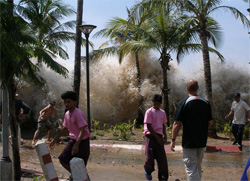Tsunami Puzzle Explained
A tsunami normally consists of multiple waves, and in some cases, the first wave is not the tallest or the most damaging. A computer simulation described 16 September in Physical Review Letters explains why the secondary waves can wash farther onshore than the initial wave. These later waves can be amplified by a resonance effect if each wave arrives at the beach just after the previous wave has receded. The new findings could change the way governments monitor and prepare for tsunamis.
When a water wave crashes onshore, the vertical height above sea level to which it rises is called the run-up. Researchers have standard equations to model large waves, but the simulations have so far been unable to reproduce maximum run-up values from some actual tsunamis, like the one that hit the south coast of Java on 17 July 2006. Researchers attributed the additional run-up to local effects, such as underwater landslides, but a team led by Frederic Dias at University College Dublin suspected there was something else at work.
“Before, when people studied the run-up problem, they would consider only one wave climbing on the beach and receding,” says Dias. Rather than one giant wave crest, a tsunami is actually a series of crests and troughs. Tsunamis are triggered in the deep ocean, usually by underwater earthquakes. In deep water, a tsunami has a small amplitude and will often pass by boats undetected. But as it approaches the shore, the tsunami slows down, while its frequency remains the same, which increases the height of the waves.
Dias and his colleagues thought that these waves could interact with the shore in a way that would amplify the later-arriving ones. After the first wave crashes onshore, it recedes, and the water sinks below normal sea level. The depressed water level contains potential energy, like a compressed spring. This energy would cause the water to rise back above sea level, whether or not more waves were following. But if the next wave arrives at the right time, just as the water is rising again, it gets an energy boost that increases its run-up. The third wave, following the same process, may have an even higher run-up. This resonance condition occurs only if the frequency of arriving waves matches the rate at which they recede, which depends on the slope of the beach.
To test their idea, the team first simulated the run-up for a perfectly smooth beach. When the incoming waves’ frequency matched the beach slope, they saw amplification by up to 60 times for the steepest slope–much larger than they expected.
Next, the researchers varied the underwater features (called the bathymetry) of their simulated beaches, as real beaches have bumps and valleys that could affect resonance. They simulated the tsunami that struck the Mentawai Islands on 25 October 2010 using the real bathymetry from the region. “The surprise was that when we moved to a more realistic bathymetry, it did not destroy the possibility of resonance,” Dias says. In fact, they found even more evidence for resonance. Though the run-up amplification factor was not as great as for the smooth beach, the team saw resonances at several possible tsunami wavelengths using the Mentawai Islands bathymetry.
“I think they really hit something,” says Paul Milewski of the University of Wisconsin, Madison. He notes that the findings could point the scientific community toward a more probabilistic approach to tsunami monitoring, whereby warnings could be sent to the “danger zones” for high run-up from resonance effects. Milewski says the findings could also apply to questions of erosion and coastal wave dynamics.
–Catherine Lussenhop
Catherine Lussenhop is a freelance writer in Minneapolis.





